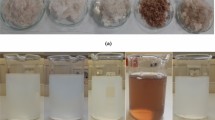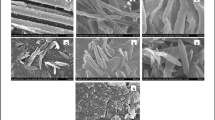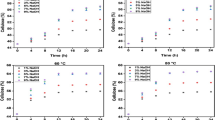Abstract
With the aim of identifying new sources for cellulose manufacturing, post-harvest tomato plant residue (TPR) was proposed in this study as a viable and sustainable source for the extraction of cellulose derivatives, namely cellulose microfibers (CMF) and cellulose nanocrystals (CNC). Pure CMF with an average diameter of 20 µm were successfully produced by subjecting the raw TPR to chemical treatments and then characterized in terms of their morphology and physico-chemical characteristics. By subjecting CMF to sulfuric, phosphoric and citric/hydrochloric acid hydrolysis, sulfated CNC (S-CNC), phosphorylated CNC (P-CNC) and carboxylated CNC (C-CNC) have been successfully produced. This was done to produce CNC with different characteristics and surface functionalities depending on the inserted functional groups during the acid hydrolysis process. By using several characterization techniques, it was found that all the extracted CNC characterized by cellulose I structure, with a crystallinity index of 81–89, 81 and 78%, an aspect ratio of 40–49, 98 and 67 and zeta potential of − 27.8 to − 37.3, − 36.9 and − 22.3 mV for S-CNC, P-CNC and C-CNC, respectively. The determined thermal stability of all extracted CNC is relatively higher than that generally obtained for S-CNC from other sources, which suffer from limited thermal stability. The produced CNC with different surface functionalities formed stable colloidal suspensions in polar solvents such as water and dimethyl sulfoxide. The production of CMF and CNC from this underutilized waste has the potential to add value to the post-harvest tomato plant, which is produced annually as waste in vast quantities throughout the world, in addition to significantly reducing the volume of cumulative waste in the environment.









Similar content being viewed by others
References
Abraham E, Deepa B, Pothen LA et al (2013) Environmental friendly method for the extraction of coir fibre and isolation of nanofibre. Carbohydr Polym 92:1477–1483. https://doi.org/10.1016/j.carbpol.2012.10.056
Aramrueang N, Zicari SM, Zhang R (2017) Biomass and Bioenergy Characterization and compositional analysis of agricultural crops and residues for ethanol production in California. Biomass Bioenergy 105:288–297. https://doi.org/10.1016/j.biombioe.2017.07.013
Bugatti V, Brachi P, Viscusi G, Gorrasi G (2019) Valorization of tomato processing residues through the production of active bio-composites for packaging applications. Front Mater 6:1–10. https://doi.org/10.3389/fmats.2019.00034
Camarero Espinosa S, Kuhnt T, Foster EJ, Weder C (2013) Isolation of thermally stable cellulose nanocrystals by phosphoric acid hydrolysis. Biomacromolecules 14:1223–1230. https://doi.org/10.1021/bm400219u
Chen YW, Lee HV, Abd Hamid SB (2016a) Preparation and characterization of cellulose crystallites via Fe(III)-, Co(II)- and Ni(II)-assisted dilute sulfuric acid catalyzed hydrolysis process. J Nano Res 41:96–109. https://doi.org/10.4028/www.scientific.net/JNanoR.41.96
Chen YW, Lee HV, Juan JC, Phang SM (2016b) Production of new cellulose nanomaterial from red algae marine biomass Gelidium elegans. Carbohydr Polym 151:1210–1219. https://doi.org/10.1016/j.carbpol.2016.06.083
Cheng M, Qin Z, Chen Y et al (2017) Facile one-step extraction and oxidative carboxylation of cellulose nanocrystals through hydrothermal reaction by using mixed inorganic acids. Cellulose 24:3243–3254. https://doi.org/10.1007/s10570-017-1339-1
Chirayil CJ, Joy J, Mathew L et al (2014) Isolation and characterization of cellulose nanofibrils from Helicteres isora plant. Ind Crops Prod 59:27–34. https://doi.org/10.1016/j.indcrop.2014.04.020
Coelho CCS, Michelin M, Cerqueira MA et al (2018) Cellulose nanocrystals from grape pomace: production, properties and cytotoxicity assessment. Carbohydr Polym 192:327–336. https://doi.org/10.1016/j.carbpol.2018.03.023
Collazo-Bigliardi S, Ortega-Toro R, Chiralt Boix A (2018) Isolation and characterisation of microcrystalline cellulose and cellulose nanocrystals from coffee husk and comparative study with rice husk. Carbohydr Polym 191:205–215. https://doi.org/10.1016/j.carbpol.2018.03.022
Dufresne A, Thomas S, Pothan LA (2013) Bionanocomposites: state of the art, challenges, and opportunities. Biopolym Nanocompos. https://doi.org/10.1002/9781118609958.ch1
Eichhorn SJ, Dufresne A, Aranguren M et al (2010) Review: current international research into cellulose nanofibres and nanocomposites. J Mater Sci 45:1–33. https://doi.org/10.1007/s10853-009-3874-0
El Achaby M, El Miri N, Aboulkas A et al (2017) Processing and properties of eco-friendly bio-nanocomposite films filled with cellulose nanocrystals from sugarcane bagasse. Int J Biol Macromol 96:340–352. https://doi.org/10.1016/j.ijbiomac.2016.12.040
El Achaby M, El Miri N, Hannache H et al (2018a) Cellulose nanocrystals from Miscanthus fibers: insights into rheological, physico-chemical properties and polymer reinforcing ability. Cellulose 25:6603–6619. https://doi.org/10.1007/s10570-018-2047-1
El Achaby M, El Miri N, Hannache H et al (2018b) Production of cellulose nanocrystals from vine shoots and their use for the development of nanocomposite materials. Int J Biol Macromol 117:592–600. https://doi.org/10.1016/j.ijbiomac.2018.05.201
El Achaby M, Fayoud N, Figueroa-Espinoza MC et al (2018c) New highly hydrated cellulose microfibrils with a tendril helical morphology extracted from agro-waste material: application to removal of dyes from waste water. RSC Adv 8:5212–5224. https://doi.org/10.1039/c7ra10239a
El Achaby M, Kassab Z, Aboulkas A et al (2018d) Reuse of red algae waste for the production of cellulose nanocrystals and its application in polymer nanocomposites. Int J Biol Macromol 106:681–691. https://doi.org/10.1016/j.ijbiomac.2017.08.067
El Achaby M, Kassab Z, Barakat A, Aboulkas A (2018e) Alfa fibers as viable sustainable source for cellulose nanocrystals extraction: Application for improving the tensile properties of biopolymer nanocomposite film. Ind Crop Prod J 112:499–510. https://doi.org/10.18642/jmseat_7100121585
El Miri N, Abdelouahdi K, Barakat A et al (2015) Bio-nanocomposite films reinforced with cellulose nanocrystals: rheology of film-forming solutions, transparency, water vapor barrier and tensile properties of films. Carbohydr Polym 129:156–167. https://doi.org/10.1016/j.carbpol.2015.04.051
Fortunati E, Puglia D, Monti M et al (2013) Extraction of cellulose nanocrystals from Phormium tenax fibres. J Polym Environ 21:319–328. https://doi.org/10.1007/s10924-012-0543-1
Fritsch C, Staebler A, Happel A et al (2017) Processing, valorization and application of bio-waste derived compounds from potato, tomato, olive and cereals: a review. Sustainability 9:1–46. https://doi.org/10.3390/su9081492
Hafemann E, Battisti R, Marangoni C, Machado RAF (2019) Valorization of royal palm tree agroindustrial waste by isolating cellulose nanocrystals. Carbohydr Polym 218:188–198. https://doi.org/10.1016/j.carbpol.2019.04.086
Herrera MA, Mathew AP, Oksman K (2012) Comparison of cellulose nanowhiskers extracted from industrial bio-residue and commercial microcrystalline cellulose. Mater Lett 71:28–31. https://doi.org/10.1016/j.matlet.2011.12.011
Hua X, Xu S, Wang M et al (2017) Effects of high-speed homogenization and high-pressure homogenization on structure of tomato residue fibers. Food Chem 232:443–449. https://doi.org/10.1016/j.foodchem.2017.04.003
Ilangovan M, Guna V, Hu C et al (2018) Curcuma longa L. plant residue as a source for natural cellulose fibers with antimicrobial activity. Ind Crops Prod 112:556–560. https://doi.org/10.1016/j.indcrop.2017.12.042
Jankowska I, Pankiewicz R, Pogorzelec-Glaser K et al (2018) Comparison of structural, thermal and proton conductivity properties of micro- and nanocelluloses. Carbohydr Polym 200:536–542. https://doi.org/10.1016/j.carbpol.2018.08.033
Jiang F, Hsieh YL (2015a) Cellulose nanocrystal isolation from tomato peels and assembled nanofibers. Carbohydr Polym 122:60–68. https://doi.org/10.1016/j.carbpol.2014.12.064
Jiang F, Hsieh Y (2015b) Cellulose nanocrystal isolation from tomato peels and assembled nanofibers. Carbohydr Polym. https://doi.org/10.1016/j.carbpol.2014.12.064
Kallel F, Bettaieb F, Khiari R et al (2016) Isolation and structural characterization of cellulose nanocrystals extracted from garlic straw residues. Ind Crops Prod 87:287–296. https://doi.org/10.1016/j.indcrop.2016.04.060
Kargarzadeh H, Ahmad I, Abdullah I et al (2012) Effects of hydrolysis conditions on the morphology, crystallinity, and thermal stability of cellulose nanocrystals extracted from kenaf bast fibers. Cellulose 19:855–866. https://doi.org/10.1007/s10570-012-9684-6
Kargarzadeh H, Ioelovich M, Ahmad I et al (2017a) Methods for extraction of nanocellulose from various sources. Handb Nanocellul Cellul Nanocompos. https://doi.org/10.1002/9783527689972.ch1
Kargarzadeh H, Mariano M, Huang J et al (2017b) Recent developments on nanocellulose reinforced polymer nanocomposites: a review. Polymer (Guildf) 132:368–393. https://doi.org/10.1016/j.polymer.2017.09.043
Kassab Z, Aziz F, Hannache H et al (2019a) Improved mechanical properties of k-carrageenan-based nanocomposite films reinforced with cellulose nanocrystals. Int J Biol Macromol 123:1248–1256. https://doi.org/10.1016/j.ijbiomac.2018.12.030
Kassab Z, Ben Youcef H, Hannache H, El Achaby M (2019b) Isolation of cellulose nanocrystals from various lignocellulosic materials: physico-chemical characterization and application in polymer composites development. Mater Today Proc 13:964–973. https://doi.org/10.1016/j.matpr.2019.04.061
Kassab Z, El Achaby M, Tamraoui Y et al (2019c) Sunflower oil cake-derived cellulose nanocrystals: extraction, physico-chemical characteristics and potential application. Int J Biol Macromol 136:241–252. https://doi.org/10.1016/j.ijbiomac.2019.06.049
Kassab Z, Syafri E, Tamraoui Y et al (2019d) Characteristics of sulfated and carboxylated cellulose nanocrystals extracted from juncus plant stems. Int J Biol Macromol. https://doi.org/10.1016/j.ijbiomac.2019.11.023
Kassab Z, Mansouri S, Tamraoui Y et al (2020) Identifying Juncus plant as viable source for the production of micro- and nano-cellulose fibers: application for PVA composite materials development. Ind Crops Prod 144:112035. https://doi.org/10.1016/j.indcrop.2019.112035
Lamaming J, Hashim R, Sulaiman O et al (2015) Cellulose nanocrystals isolated from oil palm trunk. Carbohydr Polym 127:202–208. https://doi.org/10.1016/j.carbpol.2015.03.043
Lozano FJ, Lozano R (2018) Assessing the potential sustainability benefits of agricultural residues: biomass conversion to syngas for energy generation or to chemicals production. J Clean Prod 172:4162–4169. https://doi.org/10.1016/j.jclepro.2017.01.037
Luzi F, Puglia D, Sarasini F et al (2019) Valorization and extraction of cellulose nanocrystals from North African grass: Ampelodesmos mauritanicus (Diss). Carbohydr Polym 209:328–337. https://doi.org/10.1016/j.carbpol.2019.01.048
Mahmud MM, Perveen A, Jahan RA et al (2019) Preparation of different polymorphs of cellulose from different acid hydrolysis medium. Int J Biol Macromol 130:969–976. https://doi.org/10.1016/J.IJBIOMAC.2019.03.027
Meng F, Wang G, Du X et al (2019) Extraction and characterization of cellulose nanofibers and nanocrystals from liquefied banana pseudo-stem residue. Compos Part B Eng 160:341–347. https://doi.org/10.1016/j.compositesb.2018.08.048
Mikulcová V, Bordes R, Minařík A, Kašpárková V (2018) Pickering oil-in-water emulsions stabilized by carboxylated cellulose nanocrystals—effect of the pH. Food Hydrocoll 80:60–67. https://doi.org/10.1016/j.foodhyd.2018.01.034
Mohamed MA, Salleh WNW, Jaafar J et al (2015) Physicochemical properties of “green” nanocrystalline cellulose isolated from recycled newspaper. RSC Adv 5:29842–29849. https://doi.org/10.1039/c4ra17020b
Ng HM, Sin LT, Tee TT et al (2015) Extraction of cellulose nanocrystals from plant sources for application as reinforcing agent in polymers. Compos Part B Eng 75:176–200. https://doi.org/10.1016/j.compositesb.2015.01.008
Nisticò R, Evon P, Labonne L et al (2018) Post-harvest tomato plants and urban food wastes for manufacturing plastic films. J Clean Prod 167:68–74. https://doi.org/10.1016/j.jclepro.2017.08.160
Oun AA, Rhim JW (2016) Isolation of cellulose nanocrystals from grain straws and their use for the preparation of carboxymethyl cellulose-based nanocomposite films. Carbohydr Polym 150:187–200. https://doi.org/10.1016/j.carbpol.2016.05.020
Pirich CL, Picheth GF, Machado JPE et al (2019) Influence of mechanical pretreatment to isolate cellulose nanocrystals by sulfuric acid hydrolysis. Int J Biol Macromol 130:622–626. https://doi.org/10.1016/j.ijbiomac.2019.02.166
Rhim JW, Reddy JP, Luo X (2015) Isolation of cellulose nanocrystals from onion skin and their utilization for the preparation of agar-based bio-nanocomposites films. Cellulose 22:407–420. https://doi.org/10.1007/s10570-014-0517-7
Santmartí A, Lee K-Y (2018) Crystallinity and thermal stability of nanocellulose. Nanocellul Sustain. https://doi.org/10.1201/9781351262927-5
Szymanska-Chargot M, Chylinska M, Gdula K et al (2017) Isolation and characterization of cellulose from different fruit and vegetable pomaces. Polymers (Basel) 9:495. https://doi.org/10.3390/polym9100495
Trache D, Donnot A, Khimeche K et al (2014) Physico-chemical properties and thermal stability of microcrystalline cellulose isolated from Alfa fibres. Carbohydr Polym 104:223–230. https://doi.org/10.1016/j.carbpol.2014.01.058
Yang B, Zhang M, Lu Z et al (2019) Comparative study of aramid nanofiber (ANF) and cellulose nanofiber (CNF). Carbohydr Polym 208:372–381. https://doi.org/10.1016/j.carbpol.2018.12.086
Yu H, Qin Z, Liang B et al (2013) Facile extraction of thermally stable cellulose nanocrystals with a high yield of 93% through hydrochloric acid hydrolysis under hydrothermal conditions. J Mater Chem A 1:3938–3944. https://doi.org/10.1039/c3ta01150j
Yu HY, Zhang DZ, Lu FF, Yao J (2016) New approach for single-step extraction of carboxylated cellulose nanocrystals for their use as adsorbents and flocculants. ACS Sustain Chem Eng 4:2632–2643. https://doi.org/10.1021/acssuschemeng.6b00126
Zh K, El Gendy NS, Ha A et al (2018) Upgrading of tomato (Solanum lycopersicum) agroindustrial wastes. J Microb Biochem Technol 10:46–48. https://doi.org/10.4172/1948-5948.1000394
Zhang PP, Tong DS, Lin CX et al (2014) Effects of acid treatments on bamboo cellulose nanocrystals. Asia-Pac J Chem Eng 9:686–695. https://doi.org/10.1002/apj.1812
Acknowledgments
The financial assistance of the Office Chérifien des Phosphates (OCP S.A.) in the Moroccan Kingdom toward this research is hereby acknowledged. The authors would like to thank Dr. Youssef TAMRAOUI from Materials Science and Nanoengineering Department (MSN), Mohammed VI Polytechnic University (UM6P) for his help to achieve the XRD analysis of the studied materials.
Author information
Authors and Affiliations
Corresponding author
Additional information
Publisher's Note
Springer Nature remains neutral with regard to jurisdictional claims in published maps and institutional affiliations.
Rights and permissions
About this article
Cite this article
Kassab, Z., Kassem, I., Hannache, H. et al. Tomato plant residue as new renewable source for cellulose production: extraction of cellulose nanocrystals with different surface functionalities. Cellulose 27, 4287–4303 (2020). https://doi.org/10.1007/s10570-020-03097-7
Received:
Accepted:
Published:
Issue Date:
DOI: https://doi.org/10.1007/s10570-020-03097-7




